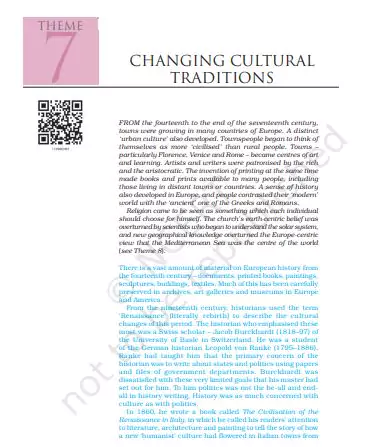‘NCERT Solutions for Class 11 History Chapter 7 Changing Cultural Traditions‘ PDF Quick download link is given at the bottom of this article. You can see the PDF demo, size of the PDF, page numbers, and direct download Free PDF of ‘Ncert Class 11 History Chapter 7 Exercise Solution’ using the download button.
Changing Cultural Traditions Textbook With Solution PDF Free Download

Chapter 7: Changing Cultural Traditions
After the fall of the western Roman Empire, many of the towns that had been political and cultural centres in Italy fell into ruin.
There was no unified government, and the Pope in Rome, who was sovereign in his own state, was not a strong political figure.
While western Europe was being reshaped by feudal bonds and unified under the Latin Church, and eastern Europe under the Byzantine Empire, and Islam was creating a common civilisation further west, Italy was weak and fragmented.
However, it was these very developments that helped in the revival of Italian culture. With the expansion of trade between the Byzantine Empire and the Islamic countries, the ports on the Italian coast revived.
From the twelfth century, as the Mongols opened up trade with China via the Silk Route (see Theme 5) and as trade with western European countries also increased, Italian towns played a central role.
They no longer saw themselves as part of a powerful empire, but as independent city-states.
Two of these Florence and Venice – were republics, and many others were court-cities, ruled by princes. One of the most vibrant cities was Venice, another was Genoa.
They were different from other parts of Europe – the clergy were not politically dominant here, nor were there powerful feudal lords.
Rich merchants and bankers actively participated in governing the city, and this helped the idea of citizenship to strike root.
Even when these towns were ruled by military despots, the pride felt by the townspeople in being citizens did not weaken The earliest universities in Europe had been set up in Italian towns.
The universities of Padua and Bologna had been centres of legal studies from the eleventh century.
Commerce being the chief activity in the city, there was an increasing demand for lawyers and notaries (a combination of solicitor and record-keeper) to write and interpret rules and written agreements without which trade on a large scale was not possible.
Law was therefore a popular subject of study, but there was now a shift in emphasis. It was studied in the context of earlier Roman culture. Francesco Petrarch (1304-78) represented this change. To Petrarch, antiquity was a distinctive civilisation which could be best understood through the actual words of the ancient Greeks and Romans.
He, therefore, stressed the importance of a close reading of ancient authors. This educational programme implied that there was much to be learnt which religious teaching alone could not give.
This was the culture which historians in the nineteenth century were to label ‘humanism’. By the early fifteenth century, the term ‘humanist’ was used for masters who taught grammar, rhetoric, poetry, history and moral philosophy.
The Latin word humanitas, from which ‘humanities’ was derived, had been used many centuries ago by the Roman lawyer and essayist Cicero (106-43 BCE), a contemporary of Julius Caesar, to mean culture.
These subjects were not drawn from or connected with religion, and emphasised skills developed by individuals through discussion and debate.
These revolutionary ideas attracted attention in many other universities, particularly in the newly established university in Petrarch’s own home-town of Florence.
Till the end of the thirteenth century, this city had not made a mark as a centre of trade or of learning, but things changed dramatically in the fifteenth century
| Author | NCERT |
| Language | English |
| No. of Pages | 16 |
| PDF Size | 2 MB |
| Category | History |
| Source/Credits | ncert.nic.in |
NCERT Solutions Class 11 History Chapter 7 Changing Cultural Traditions
Questions 1.
Which elements of Greek and Roman culture were revived in the 14th and 15th centuries ?
Answer:
The religious, artistic and literary elements of Greek and Roman culture were revived in the 14th and 15th centuries.
Questions 2.
Compare details of Italian architecture of this period with Islamic architecture.
Answer:
Following are the points of comparison:
- Huge buildings were constructed under both the Italian and the Islamic architectures.
- Decoration was prominent in both the styles.
- Arch and pillars were the important characteristics of both the Italian and the Islamic architectures.
- Beautiful cathedrals and monasteries were constructed in Italian architecture, whereas large and magnificent mosques were constructed under the Islamic style of architecture.
Questions 3.
Why were Italian towns the first to experience the ideas of humanism?
Answer:
The towns of Italy were the first to experience the ideas of humanism because of the following reasons:
- Education spread in Italy by the 13th and 14th centuries.
- Humanism as a subject was first taught in Italian schools, colleges and universities. Italian people were made aware of humanist views and ideas.
- Universities were first of all developed here to spread education.
- A number of classical books were composed by Roman and Greek scholars.
Question 4.
Compare the Venetian idea of good government with those in contemporary France.
Answer:
Venice was an Italian city. This city was free from the influence of the church and feudal lords. In Venice, bankers and rich merchants played a significant role while there was absolute monarchy in France. In France, common people were deprived of their rights.
NCERT Class 11 History Textbook Chapter 7 Changing Cultural Traditions With Answer PDF Free Download
